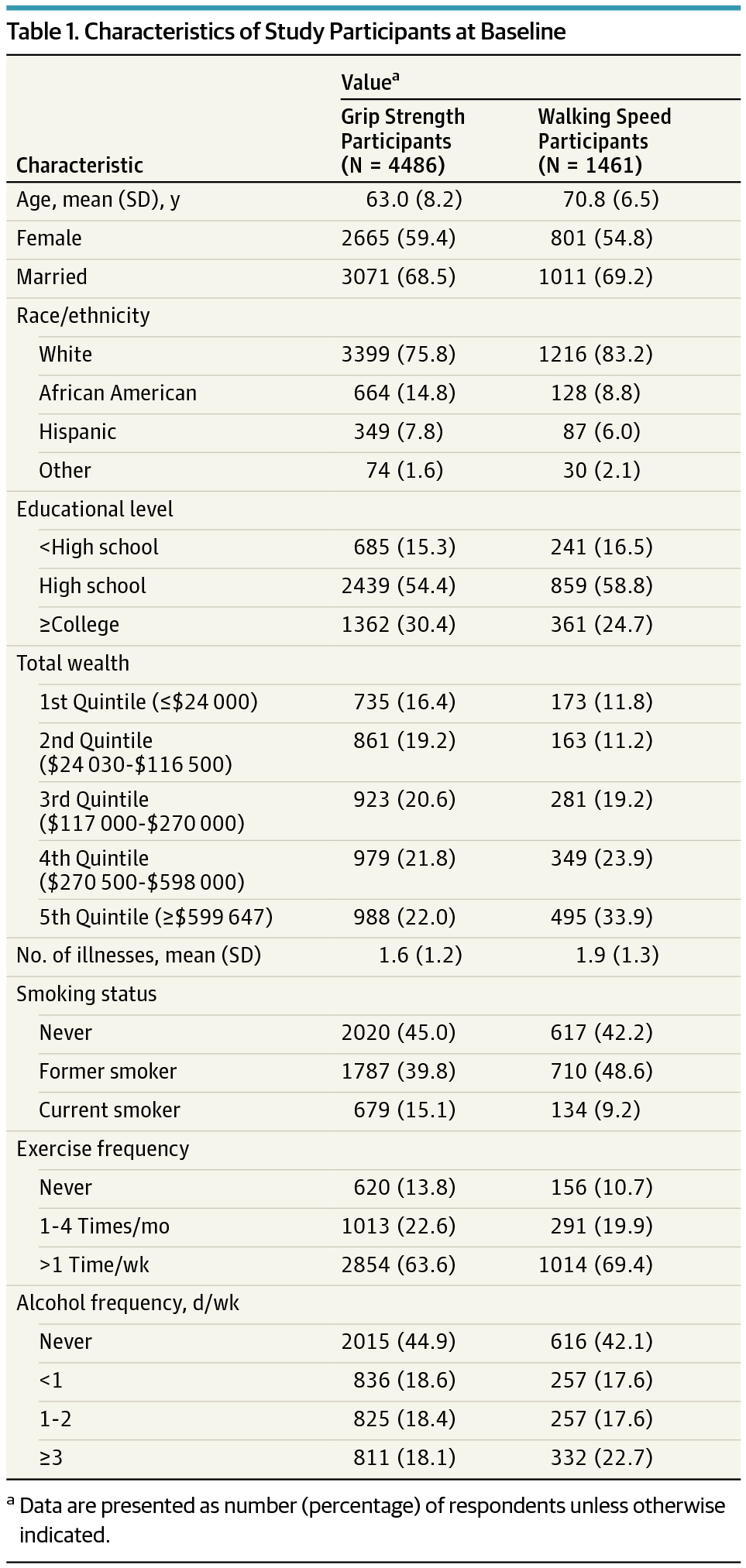JAMA Psychiatry ( IF 22.5 ) Pub Date : 2017-08-16 , DOI: 10.1001/jamapsychiatry.2017.2145 Eric S. Kim 1 , Ichiro Kawachi 2 , Ying Chen 3 , Laura D. Kubzansky 1

|
Importance Higher purpose in life is hypothesized to reduce the likelihood of developing weak grip strength and slow walking speed because purpose has been linked with a range of positive health behaviors and biological processes that are potentially protective against declining physical function. However, the association between purpose in life and objective physical function has not been examined.
Objective To assess whether higher purpose in life among adequately functioning older adults is associated with lower risk of developing weak grip strength and slow walking speed over time.
Design, Setting, and Participants Data for a longitudinal cohort study were collected in 2006 and again in 2010 from the Health and Retirement Study, a nationally representative study of US adults older than 50 years. Data analysis was conducted from November 23, 2016, to June 2, 2017.
Main Outcomes and Measures The risk of developing weak grip strength (assessed as a binary yes or no outcome) or slow walking speed (yes or no) during the 4-year follow-up period. Grip strength was assessed using Smedley spring-type hand dynamometers, and walking speed was assessed by asking respondents to walk 2.5 m at their normal walking pace.
Results In this study, 4486 adults had grip scores at baseline indicating adequate function (2665 women and 1821 men; mean [SD] age, 63.0 [8.2] years) and 1461 adults had walking scores at baseline indicating adequate function (801 women and 660 men; mean [SD] age, 70.8 [6.5] years). After controlling for sociodemographic factors, each 1-SD increase in purpose was associated with a 13% decreased risk (95% CI, 1%-23%) of developing weak grip strength and a 14% decreased risk (95% CI, 8%-20%) of developing slow walking speed. Associations with walking speed were maintained in all covariate models (fully adjusted model: risk ratio, 0.89; 95% CI, 0.83-0.95), but associations with grip strength did not reach conventional levels of statistical significance after additionally adjusting for relevant baseline health factors, depressive symptoms, and health behaviors (fully adjusted model: risk ratio, 0.91; 95% CI, 0.80-1.04).
Conclusions and Relevance Purpose in life was prospectively associated with a decreased risk of developing weak grip strength and slow walking speed, although the findings were more robust for walking speed than for grip strength. These findings suggest that a sense of purpose in life, a modifiable factor, may play an important role in maintaining physical function among older adults.
中文翻译:

人生目标与老年人身体机能客观指标之间的关联
重要性 假设较高的生活目标可以减少发展较弱的抓地力和慢速行走的可能性,因为目标与一系列积极的健康行为和生物学过程相关联,可以预防身体机能下降。但是,尚未检验生活目的与客观身体机能之间的联系。
目的 评估功能良好的老年人的较高生活目标是否与较低的握力强度和随时间推移缓慢行走速度的风险相关。
设计,设置和参与者 纵向队列研究的数据分别于2006年和2010年从健康和退休研究中收集,健康和退休研究是一项针对50岁以上美国成年人的全国代表性研究。数据分析于2016年11月23日至2017年6月2日进行。
主要结果和措施 在4年的随访期内,出现握力减弱(以二进一进的是或否评估)或步行速度慢(是或否)的风险。使用Smedley弹簧式测力计评估握力,并通过要求受访者以其正常的步行速度行走2.5 m来评估步行速度。
结果 在这项研究中,有4486名成年人在基线时的抓地力得分表明其功能正常(2665名女性和1821名男性;平均[SD]年龄为63.0 [8.2]岁),并且有1461名成年人在基线时的步行得分表明其功能良好(801名妇女和660名男性) ;平均[SD]年龄为70.8 [6.5]岁)。在控制了社会人口统计学因素之后,每增加1-SD的目的,就会使握力减弱的风险降低13%(95%CI,1%-23%),而风险降低14%(95%CI,8%) -20%的人发展缓慢的步行速度。在所有协变量模型中均保持了与步行速度的关联(完全调整的模型:风险比,0.89; 95%CI,0.83-0.95),但在另外调整了相关的基线健康因素后,与握力的关联并未达到常规的统计学意义,抑郁症状,
结论和相关性 尽管发现的步行速度要比握力要强,但生活的目的可能会降低握力减弱和步行速度减慢的风险。这些发现表明,生活中的目的感是一种可改变的因素,可能在维持老年人的身体机能中发挥重要作用。











































 京公网安备 11010802027423号
京公网安备 11010802027423号